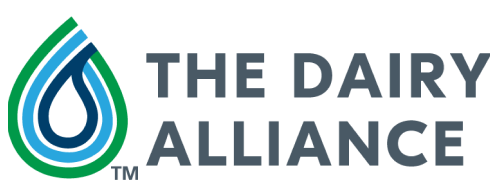Supporting Dairy Cattle Farmers on Earth Day
Discover how dairy cattle farmers contribute to Earth Day's environmental goals at The Dairy Alliance. Caring for their land and animals is second nature for dairy farmers. After all, it’s a part of their everyday lives.
On April 22, while the average consumer makes small changes to their habits for improved food sustainability in celebration of a day, dairy farmers go about their daily routine caring for their farm and their business all year long. They’re making sure their cows are milked, their land is tended to, and that they’re producing a nutritious product on Earth Day and every other day in the year.
The Sustainable Practices of Dairy Cattle Farmers
Just like you recycle in your home, dairy farmers recycle, too. Dairy farmers have created practices to use resources to their fullest potential before recycling for a continuous system. For example, water on the farm can be used up to four times for tasks like cooling fresh milk stored in a tank, providing water for cows to drink, cleaning the barns, and watering crops before treating the water to be used again.
Some resources come from the dairy cow. One cow can produce up to 100 pounds of manure each day, so responsible manure management practices are important for every farmer. This manure can be used as fertilizer for the crops grown on the farm for cow feed, but there is a new manure management method appearing on some dairy farms. Anaerobic digesters help break down cow manure or food waste for electricity, heat, and even vehicle fuel for the farm and surrounding community.
Dairy cattle farmers care about the planet just like you. They choose sustainable farming practices to help everyone.
Dairy Farming's Positive Impact on the Environment
U.S. dairy innovates for the future – in new products, technologies, and on-farm practices that will contribute to healthier people, planet, and animals. Today, there are dairy farms across the country helping local communities while helping to eliminate food waste from local businesses.
One way is through a cow’s special four-chambered stomach. Dairy cows can provide healthy nutrient sources of protein, vitamins, and minerals while reducing waste. Cows are the ultimate upcyclers with what they can eat that humans cannot. Dairy cattle farmers use food by-products like distillers’ grains, almond hulls, and citrus pulp to mix nutrient-dense feed that dairy cows eat and convert to delicious and nutritious milk. This keeps cows happy and well-fed while reducing food waste in numerous industries.
Farming can help communities by focusing on the health of the land, too. Healthy soil and clean water are the foundation of sustainable farming. Healthy soil is important to dairy farmers who grow feed for the cows, as is for clean water to irrigate the plants, clean barns, and more. There are several environmentally friendly practices to improve soil health and keep waterways clean, including planting cover crops and vegetative buffers to provide diversity and reduce soil erosion and low-till or no-till techniques to minimize disturbance to the soil.
Supporting Dairy Cattle Farmers, the Local Communities, and the U.S. Economy
Dairy farms do even more for their community than create local products and potentially provide fuel. Dairy farms also impact the economy to ensure an industry that can continue to operate through its sustainable practices.
Agriculture and its related industries, like food service or apparel, contributed $1.42 trillion to the US gross domestic production, or GDP, in 2022, with the output of American farms contributing to $223.5 billion of that total. As of 2022, agriculture and its related industries provided 10.4% of U.S. employment or 22.1 million full- and part-time jobs. On-farm employment accounted for about 2.6 million of these jobs or 1.2% of US employment.
Dairy cattle farmers do so much to protect the planet on Earth Day and every other day. This year, as you plan for a more sustainable future, be sure to include plans to support your local dairy farmers and their efforts. Begin by learning more about the sustainability efforts of Southeast dairy cattle farmers.
Support your local dairy cattle farmers by choosing dairy products at the grocery store. Fresh milk makes it from the farm to your grocery store in 48 hours, making real milk a truly local product. If you are curious about where your milk comes from, you can track its journey here.
How will you support dairy farmers this Earth Day?




